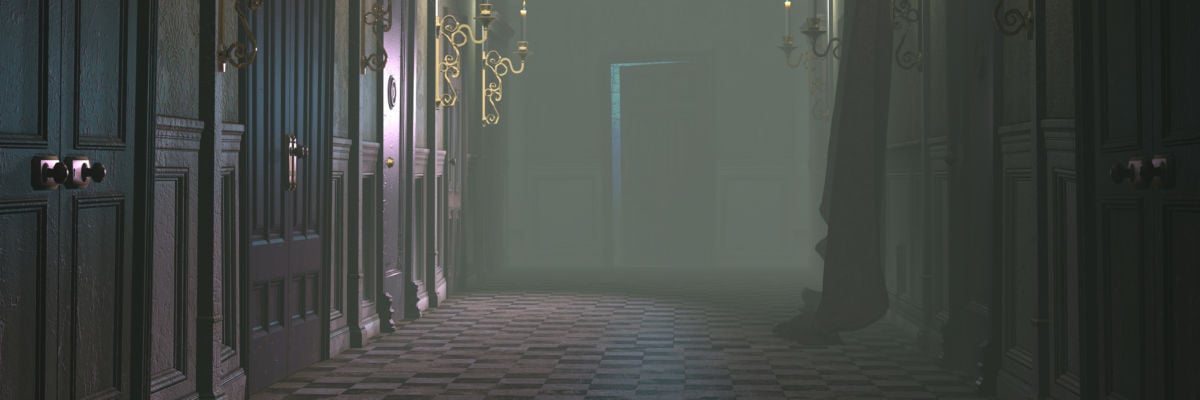
I teach at a boarding school that operates out of a venerable century-old brick building that used to be an orphanage run by the Sisters of the Greek Catholic Union. The place has seen the coming and going of countless souls. Many, now lost to anonymity, have laughed, suffered, wept, and even died within its walls. It’s one of those buildings with many memories—places with an atmosphere, that give a feeling, whether good or bad.
We have our ghosts, and the boys who attend our school are accustomed to ghost stories—as boys should be. There is a long, narrow, ill-lit, seldom-used hallway up on the third floor with closets on one side and what used to be nuns’ cells on the other. The closet doors are sometimes found inexplicably unlocked and ajar. Further, there are legends of a shadowy form at the dark end of the hall, appearing where there isn’t enough light to see anything, accompanied by the swishing sound of a broom.
The Sweeping Nun is real for the boys at our boarding school. She is accepted—just as one might accept a mouse or a creaky floorboard. These things just happen in old places, and so do they happen here, from the third-floor hall to the Water Tower up on the hill to the old Orphan Cemetery out in the back woods.
I recently had my own hair-raising experience in our building. It was late on a summer night of shrieking crickets, and the school was empty—except for Farmer John, who tended our pigs and may or may not have been rattling about. I was passing in front of the building and admiring a great big orange moon bellying up over the black Pocono ridge, when I noticed a curious light glowing dimly in the windowed sun porch above me on the second floor. I went in to investigate.
Entering the dark balcony, flanked on one side with faculty office windows and on the other with the auburn moonscape, I slipped beneath the brick archways toward the mysterious glow—only to discover a small lamp left on by the natural history teacher over a tank of pond culture. I turned away from the window and the silent seating area at the far end, shrouded in shadow.
I then heard footsteps approaching me out of the darkness. I started, and immediately intuited that Farmer John must have been sitting at the end invisibly and was now walking sharply toward me. I turned with an apology for not noticing him, but I found the darkness empty. The footsteps clacked on across the concrete floor, notwithstanding, right up to where I stood, and ceased in silence. The step was a man’s, on hard, urgent heels.
I am not a signs-and-wonders person, but I enjoy the challenge this shivering time of year poses, with its bumps in the night that seem to concern those who have passed away. As Catholics, dare we say ghosts? There is too much evidence and report to discount stories like the one I have here recounted. I don’t know what that was, but it was something.
Does it go against the grain of our Faith to believe in phantoms? Granted, much of haunted history is laced with hoax and hocus-pocus. But, on the other hand, is it right to call a place “haunted” and keep a straight face and a straight faith?
The Church doesn’t hold any dogmatic position on the matter of ghosts. So what might be said of ghosts from anything like a Catholic perspective, something that does not contradict Catholic theology? Is there any way that we can entertain what people would call “ghosts” without contradicting the doctrines of purgatory, heaven, and hell?
“The dead often do appear to the living,” wrote philosopher Peter Kreeft. “There is enormous evidence of ‘ghosts’ in all cultures.” And we mustn’t, as Carl Jung said, “commit the fashionable stupidity of regarding everything [we] cannot explain as a fraud.” As Catholics, we should be comfortable with the spiritual side of things—even if it is startling.
Catholics concede that all are spiritual beings. We have souls, we have a spirit, we bear the image of God. What’s more, all beings—whether they have souls or that divine image or not—have some spiritual aspect because existence itself is a type of supernatural reality. God is being; he is existence, He is. And all things that are must have a spiritual element or be part of a spiritual plane, insofar as they must participate in God’s existence.
As spiritual beings moving and living against the spiritual fabric of everything else, whatever that means exactly, we can perhaps, by some mystery, make and leave invisible impressions in that invisible atmosphere that surrounds us. These might be caused, we can imagine, in moments of tremendous spiritual consequence—moments of profundity, joy, sadness, terror, violence, death—and it is that impression only, like an image embedded in wax, that can manifest in things like doors, sounds, furniture, or even apparitions.
Such spiritual remnants, such lingering energies, may be what people have recognized as ghosts or ghostly presences. Whatever they are, I don’t believe they are sentient, self-conscious beings that can see us or speak to us. I think they are more like photographs or footprints left behind by some powerful spiritual event. By this thought, these phenomena would be akin to mystical “weather events” in the spiritual atmosphere of a place.
I once heard about a European priest who visited a parishioner’s family and, upon arriving, asked after the children. Their mother said they were in the next room, playing under a table. “Under a table?” The priest asked. “Yes, they like playing under there for some reason.” Approaching the table, where he could hear their little voices, the priest suddenly paused.
The children were singing—and from his musical studies, the priest recognized an old form of sacred chant. “Who taught you to sing that?” he asked. The children replied matter-of-factly, “The table taught us.” The priest traced the antique table to a period and place where it had been used as an altar during a time of persecution—a time when such chants may well have been sung at Mass.
It short, according to these musings, spiritual beings and spiritual events may be able to make a mark. In other words, we change the places where we live, where life happens. We leave behind wispy traces, enduring memories—or hauntings. That is one way of assigning some cause to the unaccountable events that so many have experienced without contradicting the doctrines of where souls reside after death. For, as Hamlet famously put it, “there are more things in heaven and earth, Horatio, than are dreamt of in your philosophy.”
This is not to deny that visitations from the departed have been permitted by God for some holy purpose, or that the dark powers that hate God and his children cannot control manifestations for some dread purpose. There are times when the blessed have communed with those on earth. But none of these spiritual demonstrations, which St. Thomas Aquinas wrote about with thirteenth-century credence, is a ghost in the way that we tend to imagine ghosts.
There is plenty of room for speculation when it comes to specters. But it is remarkable how, almost across the board, ghosts rarely seem to be accomplishing any purpose. They open doors or sweep hallways. They flit by and stare and rarely speak. And though some say that these are attempts at communication, it always seems humdrum. Who’s to say?
How these mundane manifestations fit in with moments of spiritual significance might point to how the simplest things in our lives can be of eternal moment. For all we know, that hallway and a broom were the means of a nun’s salvation. But if we might apply any purpose or point to any of these mysteries, it is simply to pray for the dead—to help those along as we may to their final resting place, which is not an earthly place.



